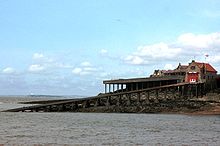RNLI
The RNLI has saved more than 139,000 lives since its foundation in 1824. Through the years, there have been countless stories of courage against a background of technological developments and social change. Recent years have seen some major developments, with the introduction of RNLI lifeguards in 2001, and the first lifeboat station on an inland waterway, also in 2001. The RNLI Heritage Trust preserves the history of the RNLI by caring for its collections and archives that tell the story of the service since 1824 The RNLI operates three classes of inshore lifeboats, bothinflatable boats and RIBs, of 25-40 knots, and five classes of all-weather motor life boats, with another (FCB2) currently in development, with speeds ranging from 17 to 25 knots. It maintains 332 lifeboats based at 235 lifeboat stations. It also has four hovercraft, introduced in 2002, allowing rescue on mud flats and in river estuaries inaccessible to conventional boats. The crews of the lifeboats are almost entirely volunteers. The 4,600 boat crew members, including over 300 women, are alerted by pagers and attend the lifeboat station when alerted.
The charity was founded, with royal patronage, as the National Institution for the Preservation of Life from Shipwreck after an appeal made by Sir William Hillary. Hillary lived in Douglas on the Isle of Man, and had witnessed the wrecking of dozens of ships from his home.
The name was changed to the Royal National Lifeboat Institution in 1854, and cork lifejackets were first issued to crew members in the same year.
In 1891, the first RNLI street collection was held in Manchester. The 20th century saw the RNLI continue to save lives through two world wars. The lifeboats moved from sail and oar power to petrol and diesel, and the first women joined their crews.

Weston-super-Mare lifeboat station has the longest lifeboat slipway in the country. However, due to the age of the slipway, it is now not used, and the two lifeboats stationed there are launched from the other side of the pier, down the beach. |
The Humber lifeboat station at Spurn Point, East Riding of Yorkshire is one of only four lifeboat stations in the UK which are crewed full time (the others being Tower Lifeboat Station at Waterloo Bridge, Chiswick Station and the Gravesend, KentStation, all on the River Thames). The crew live in a few houses on Spurn Point, which in bad weather can be cut off from the mainland. The other occupants of Spurn Point areAssociated British Ports, who man their Vessel Traffic Servicecontrol tower 24 hours a day, 365 days a year along with the lifeboat crew.
Throughout Ireland and Great Britain, ships in distress or the public reporting an accident must contact the Emergency services:
- by telephoning 999 or 112
- on Medium frequency (frequency 2182 kHz),
- or on VHF radio (Channel 16)
The call will then be redirected to HM Coastguard or the Irish Coast Guard, as appropriate.
The Coastguard co-ordinates air-sea rescue and may call on the RNLI (or other lifeboats) or their own land-based rescue personnel or rescue helicopters to take part. Air-Sea rescuehelicopters are provided by CHC Helicopter ,the Royal Air Force, the Royal Navy, the Marine & Coastguard Agency (HM Coastguard), and the Irish Air Corps.
The biggest rescue in the RNLI's history was 17 March 1907 when the 12,000 tonne liner SS Suevic hit the Maenheere Reef near Lizard Point in Cornwall. In a strong gale and dense fog, RNLI lifeboat volunteers rescued 456 passengers, including 70 babies. Crews from The Lizard, Cadgwith,Coverack and Porthleven rowed out repeatedly for 16 hours to rescue all of the people on board. Six silver RNLI medals were later awarded, two to Suevic crew members.
TO SUPPORT THE GREAT WORK THEY DO, VISIT: RNLI HOMEPAGE
RNLI stands for Royal National Lifeboat Institution and is a charity that saves lives at sea in the UK! The RNLI is funded by Volantary Donations only and is run by Volantary Crew Members, these crew members are on call all the time like for the fire service but they dont get paid. These Volantary Crew Members rick their own lives regualary to save the lives of others! The RNLI cost around £405,000 a day, thats about £147.7million a year!
PLEASE visit their website and help, or donate towards the great work they do that... SAVES LIVES!